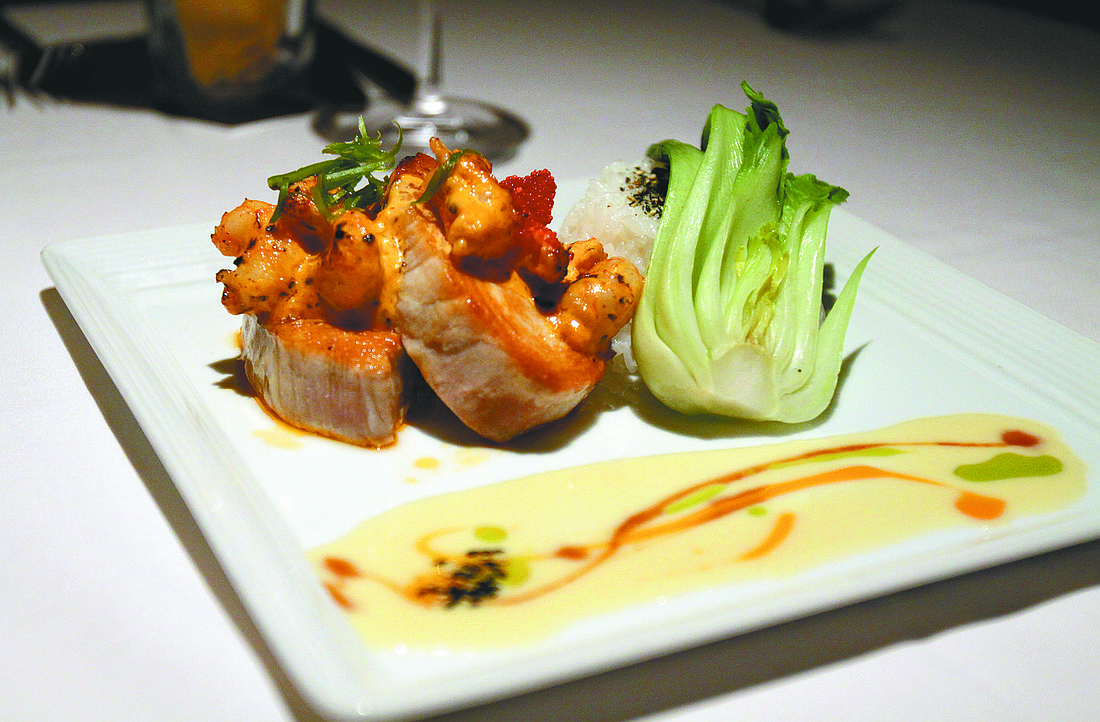- November 28, 2024
-
-
Loading

Loading

This is an experiment. “What’s your favorite restaurant” is one of Sarasota’s favorite talk topics. The idea here is to take that conversation into print and share what interesting people have to say. Whether it becomes a regular feature depends in large part on how you — our readers — like it. So, take a minute to log ontoYourObserver.com and comment on this story. Or e-mail me at [email protected].
Happy dining out.
Who’s talking?
Marian Strickland and Pauline McClendon are the most sisterly sisters you can imagine. They live together in North Sarasota about 50% of the time — Pauline spends the other half of her time in Texas.
They work together. They work out together. And they eat out together — for lunch almost every day and for dinner twice a week or more.
Their business is MK Designs. They create one-of-a-kind, fine-jewelry pieces featuring rare and unusual stones sold at Golden Image, on Palm Avenue, and on the Web at www.mkdesigns.com. Marian is the designer, Golden Image owner Peter Woodruff crafts the pieces, and Pauline handles the business side.
What’s their favorite?
Encouraged to pick just one, the sisters quickly settled on Roy’s. They go there automatically for occasions and with out-of-town company.
“We rarely even think about it, we just do it,” Marian says. “And, should we think about it, we come back to Roy’s.”
Both sisters are conscious of eating healthfully. Pauline is an omnivore, and Marian is a pescaterian.
Roy’s food also appeals to their instincts as jewelers.
“I love the presentation; it’s jewel-like,” Marian says.
The sisters agree that “the service always makes you feel special, the food is consistent and the atmosphere is different from other places.”
What do they eat?
Roy’s specialty is “Hawaiian Fusion Cuisine” — a category created by founder Roy Yamaguchi in 1988 in Hawaii that is defined by five elements: fish, classic French technique and saucing, local produce, bold Asian spices and an “aloha spirit.”
The chef/partner at the Sarasota Roy’s is Justin Fields. According to Fields, the menu at Roy’s consists of roughly two-thirds corporate classics and one-third original creations by the local team. He describes his personal approach as adventurous.
“I like to take risks and put together ingredients and ideas that others wouldn’t think of,” Fields says.
The featured recipe below is his creation. Fields suggests Whole Foods as a source for the Hawaiian fish. The Asian ingredients are available locally at Oriental Food and Gifts, in Gulf Gate, and Phuoc Luc Tho, 1944 12th St.
RECIPE
Rock shrimp dynamite crusted Hawaiian ono
Ono tends to be dry in texture, so the crust helps to retain its natural moisture; deep-frying is another good cooking method for ono, for the same reason. Serve with braised baby bok choy and steamed rice. Blue or striped marlin is an acceptable substitute for ono, or ask your fishmonger.
INGREDIENTS: (serves 4)
Dynamite crust
1 tablespoon sesame oil
1 tablespoon minced garlic
1 teaspoon fish sauce
2/3 cup mayonnaise
4 ounces poached and chilled rock shrimp
2 teaspoons rayu (spicy sesame oil)
2 teaspoons furikake
1 teaspoon sichimi togarashi
1 teaspoon soy sauce
salt and freshly ground black pepper
1 teaspoon chopped cilantro
1 teaspoon chopped chives
2 tablespoons olive oil
4 (7-ounce) ono steaks
1 tablespoon masago caviar (smelt roe) or tobiko caviar
• To prepare the crust, heat the sesame oil in a sauté pan or skillet over medium-high heat. Add the garlic and sauté for about two minutes, or until lightly browned. Stir in the fish sauce and cool. Put the mayonnaise in a bowl and add the garlic mixture, rock shrimp, rayu, furikake, sichimi togarashi, soy sauce, herbs and salt and pepper to taste. Stir well until thoroughly combined.
• Preheat the broiler. Place four scoops of the crust mixture in a baking pan and spread each out with a spatula to the size of each piece of ono. Broil the crust 5-to-6 inches from the heat source for about two minutes, or until golden brown. Set aside and keep warm.
• To prepare the fish and accompaniments, heat the olive oil in a large heavy sauté pan or skillet over medium-high heat. Sear the ono for two to three minutes on each side, or until opaque throughout. Transfer to warmed plates, place a crust on top of each fish, and garnish with the caviar.
RECIPE
Crab and artichoke crusted Hawaiian opah
Serves four
Although caught year-round, opah is most common in Hawaii between April and August. It is regarded by Hawaiians as a fish that brings good luck, and so is often given away by private fishermen as a gesture of goodwill. Serve with fingerling potatoes and steamed broccolini. Mahi or swordfish can be substituted for opah, or ask your fishmonger.
Crab and artichoke crust:
2 cups cooked artichoke hearts, roughly chopped (canned is OK)
1/2 cup basil, chiffonade
1/2 cup thyme, chopped
1/2 cup garlic, chopped
1/2 cup olive oil
1 cup blue crab claw meat
3/4 cup mayo
1/4 cup whole grain mustard
juice of one lemon
zest of one lemon
1 cup shredded Parmesan cheese
salt and pepper to taste
2 tablespoons olive oil
4 (7-ounce) opah steaks (from the back)
Salt and pepper to taste
To prepare the crust, sauté garlic, herbs and artichokes in olive oil over medium-high heat. Drain oil, and spread mixture over a sheet pan to cool. In a bowl, combine all ingredients and stir to thoroughly combine. Hold at room temperature.
Heat the oil in a heavy nonstick sauté pan or skillet over medium heat. Add the opah, searing for two to three minutes on each side, or until opaque throughout. Transfer opah fillets to sheet pan. Spread the crab mixture on one side of each fillet to form a crust. Broil the opah five-to-six inches from the heat source for about two minutes, or until golden brown.